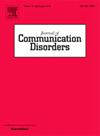使用评分模板确定青少年社会沟通干预的干预目标
IF 2.1
3区 医学
Q2 AUDIOLOGY & SPEECH-LANGUAGE PATHOLOGY
引用次数: 0
摘要
随着青少年从义务教育阶段过渡到成人阶段,社交是一项有沟通障碍风险的关键技能。确定适合个人的干预目标需要来自以下评估的信息:1)描述考生当前的社会沟通能力水平;2)识别超出考生当前能力水平的可能对考生构成挑战的技能。目的本研究的目的是评估一种新的青少年社交沟通评估的心理测量特性,并探讨Rasch键表——一种将考生的整体能力与其单项工具项目的得分联系起来的评分模板——是否为干预目标选择提供了可解释的评估输出。方法采用新型过渡语用访谈法(TPI);Poll et al., 2024)对109名具有不同社会沟通能力的青少年(14 - 21岁)进行了研究。数据采用Rasch分析评估TPI的心理测量学。为三个不同能力水平的参与者生成了与就业相关的TPI项目的键盘表格。结果分析支持TPI是一个一维的、可靠的量表。键盘显示有助于识别三个典型受访者的过渡区域。过渡区域是与新出现的参与者能力相关的难度级别的道具集。结论stpi关键表格详细描述了参与者目前的能力水平,并确定了下一个最具挑战性的项目。本文回顾了三个典型受访者的数据,以展示关键表格如何在结合考生的职业目标、学术标准和社会沟通行业标准时提供信息,以确定适当的社会沟通干预目标。本文章由计算机程序翻译,如有差异,请以英文原文为准。
Using a scoring template to identify intervention goals for adolescent social communication interventions
Background
Social communication is a critical skill for adolescents at risk for communication disorders as they transition from compulsory education to adult contexts. Identifying intervention goals that are well tailored to the individual requires information from assessments that 1) describe the examinee's present level of social communication ability and 2) identify skills that are just beyond the examinee's current ability level that may challenge the examinee.
Purpose
The purpose of this study was to evaluate the psychometric properties of a new assessment of social communication for adolescents, and to explore whether a Rasch keyform – a scoring template that links an examinee's overall ability to their scores on individual instrument items–provides an interpretable assessment output for intervention goal selection.
Method
The new Transition Pragmatics Interview (TPI; Poll et al., 2024) was administered to 109 adolescents (14 to 21 years) of varied social communication abilities. Data were analyzed using Rasch analysis to evaluate the psychometrics of the TPI. Keyform displays for employment-related TPI items were generated for three participants at different levels of ability.
Results
Analyses supported the TPI as a unidimensional and reliable scale. Keyform displays facilitated the identification of transition zones for each of the three exemplar respondents. Transition zones are item sets at difficulty levels associated with emerging participant abilities.
Conclusions
TPI keyforms detailed the present level of participant ability and identified items which would be the next most challenging. Data from three exemplar respondents were reviewed in order to show how keyforms could provide information to identify appropriate social communication intervention goals when combined with the examinee's career goals, academic standards, and industry standards for social communication.
求助全文
通过发布文献求助,成功后即可免费获取论文全文。
去求助
来源期刊

Journal of Communication Disorders
AUDIOLOGY & SPEECH-LANGUAGE PATHOLOGY-REHABILITATION
CiteScore
3.30
自引率
5.90%
发文量
71
审稿时长
>12 weeks
期刊介绍:
The Journal of Communication Disorders publishes original articles on topics related to disorders of speech, language and hearing. Authors are encouraged to submit reports of experimental or descriptive investigations (research articles), review articles, tutorials or discussion papers, or letters to the editor ("short communications"). Please note that we do not accept case studies unless they conform to the principles of single-subject experimental design. Special issues are published periodically on timely and clinically relevant topics.
 求助内容:
求助内容: 应助结果提醒方式:
应助结果提醒方式:


